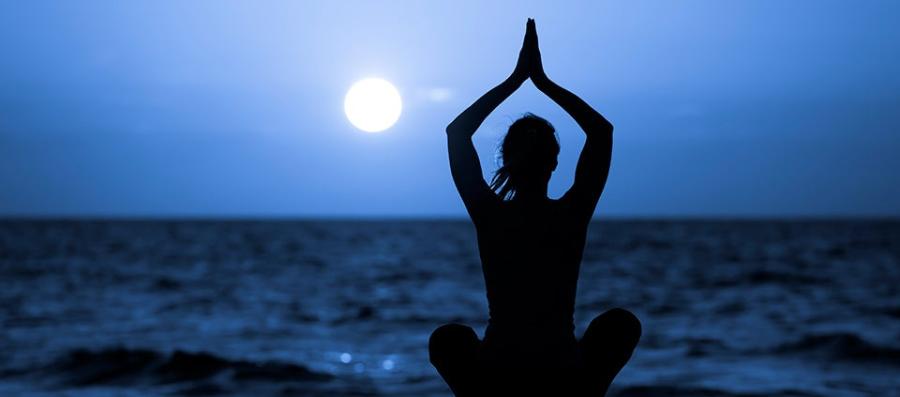Moonstruck


I grew up with a glow-in-the-dark moon on my ceiling—cantaloupe-sized, always full. I felt comforted by its odd light, its pocked surface.
During a fifth-grade trip to Ocean Point, Maine, I began to appreciate the moon’s power in earnest. Our task was to explore tidal pools for living things: seaweed, snails, mussels (locked shut and secret), an occasional baby crab. The water was thick with green algae, but our teacher encouraged us to stick our hands in, to find evidence of creatures that could thrive there. The moon was responsible, she explained, for the existence of these strange puddles, because the moon caused the endless push and pull of the ocean’s tides.
We’d recently learned that our bodies are comprised of water, up to 65 percent. I was shy and didn’t ask that day at the Point, but I wondered if the moon affected us, too, if we could feel tidal forces inside.
I know now that humans are quick to link the moon to fits and starts of all kinds, from insomnia to werewolves. “Lunacy” is from the Latin lunaticus, meaning moonstruck. In the 1700s, in England, those accused of crimes could campaign for a lighter sentence if the crime occurred under a full moon. It is said that emergency rooms are busier when the moon’s illumination is at its peak.
Yet we also see the moon as a beneficent source, both a balm and a guide. Algonquian tribes have 12 names for it, including Wolf, Worm, Strawberry, and Sturgeon, which correspond to the ideal seasons for fishing and crops.
The eight lunar phases can parallel our intentions here on earth. The days during the new moon are auspicious for a fresh start. The full moon is the phase for completing projects. In the last quarter moon, it’s the time to release and let go.
Though the craters and smudges I observed as a child are called “the man in the moon,” female idols represent the lunar sphere in cultures worldwide. In ancient Persia, she was Metra, the world mother. In Polynesia, she was the goddess Hina. Greeks called her Artemis, sister of Apollo. The Sioux name is Old Woman Who Never Dies.
Kripalu presenter Deborah Davis, an acupuncturist, qigong instructor, and medical intuitive, provides another cultural perspective. “In Chinese qigong, the moon is the ultimate expression of yin (female energy) while the sun represents the yang (masculine energy),” she says. Deborah has an answer to my unspoken question by the tidal pools, about the moon’s effect on humans as well as sea creatures: All bodies “experience the ebb and flow, the inner tides as energies wax and wane each month,” she says. “Our busy lifestyles have made it inconvenient to notice these shifts, resulting in a continual struggle to keep up, no matter how we feel. But if we honor these changes, we’ll naturally fall into more harmonious rhythms and connect intimately with our body’s needs.”
We can also hail the moon through yoga practice, says Megha Nancy Buttenheim, CEO and founding director of Let Your Yoga Dance® LLC, and a Kripalu faculty member for more than 30 years. She co-created Kripalu’s Chandra Namaskar, or Moon Salutation, which she calls “centering, grounding, flowing, and grace-filled.”
Megha explains the evolution of this sequence: “In the late 80s, I wondered why so little attention in yoga was focused on the moon, as did my Kripalu Yoga teaching colleagues. Sun Salutations come from the masculine historical tradition of yoga, but we wanted to make it more accessible to the scores of women who were getting more and more interested in the practice. While the Sun Salutation raises prana; we wanted the Moon Salute to recognize the downward flow of energy.”
Megha has since adapted the sequence for those craving a more gentle practice and for those who practice in a chair. “It keeps changing, evolving, and growing with time,” she says. “I consider the salutation to be a meditation in motion and also a prayer.”
I live far from the ocean tides now but, on winter nights, as moonlight brightens my snowy yard, I step outside and recognize its potency. Deborah calls this “moon bathing.” “You can soak in the yin energies and inhale the light into your organs and cells. This soothes, calms, and nourishes,” she says. During times of unrest, it can be a salve beaming down. I think of my glow-in-the dark moon watching over me.
Lara Tupper is a writer, teacher, singer, and “moon child,” according to her astrological sign. laratupper.com
© Kripalu Center for Yoga & Health. All rights reserved. To request permission to reprint, please e-mail editor@kripalu.org.
















































